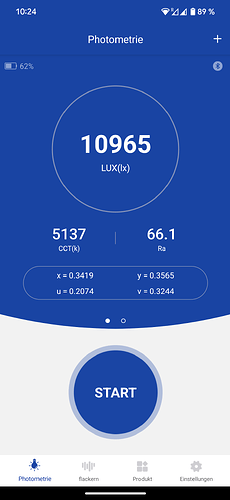LHP73B-B0-3B-J4-VU
2025-07-24
- Type: multi die, flip chip
- Bin: J4 (min 1120 lm / max 1200 lm)
- Color group: 3B (5000K)
- CRI: 70
The LHP73B tested here was purchased from Convoylight in July 2025. Many thanks to Reddit user u/Perfect_Jaguar2123 for their support!
Lumenpioneer (LMP for short) previously introduced the LML2AW.DC, a type of SST-40 clone. The LHP73B shown here corresponds to the design of an XHP70.3 HI. According to Convoylight’s description, Sanan chips are used.
The LHP73B has a simple design. Sixteen small LED chips are arranged in a square of 4x4 on a dark gray substrate and connected using the flip chip process. They are surrounded by white potting compound. The LED chips protrude slightly from the white potting compound.
With dimensions of 7.00 x 7.00 mm and the familiar 7070 footprint, these LEDs can be used freely on 7070 boards. Since the 3 V version was tested here, the permissible LED forward voltage must be observed when replacing the LED!
Changing the forward voltage to 6 V is possible with a modified footprint (connection) of the LED board. However, these boards are less commonly available, especially with DTP.
There is virtually no light emitted from the sides of the chips, except for a small yellow frame around the array of chips. The light-emitting area is 25 mm² in size.




- Maximum reached at 30 A, at this point 8869 lm @ 3.29 V
- Power at maximum 98.8 W
- Efficacy at maximum 89.8 lm/W



Data for 25 °C Tsp (at 85 °C the luminance values are around 13 % lower).
The LHP73B definitely does not break any performance records here, at least when considering pure luminous flux alone. The maximum possible operating current of 30 A (equivalent to approximately 15 A at 6 V) is lower than that of the XHP70.3 HI.
What is remarkable, however, is the extremely low forward voltage of 3.29 V, which results from the parallel connection of all 16 chips. Since the current is divided among all 16 chips, the 3.29 V applies to a current per LED chip of approximately 1.9 A (554 lm per chip). This is a good value for LED chips of this size, even though the luminous flux per LED chip is low. Performance may be limited by relatively high thermal resistance.
Efficacy is very high. At around 90 lm/W at maximum possible current, it achieves a significantly higher luminous flux than the XHP70.3 HI at the same power. It should be noted that the light-emitting area of the LHP73B is significantly larger than that of the XHP70.3 HI, which reduces the possible throw with the same reflector size.
The other LEDs shown for reference don’t stand a chance. The SFT-70 has significantly lower performance due to its design and smaller footprint; while the FFL707A is less efficient anyway due to its high color rendering index.
The luminance is similar to that of the XHP70.3 HI. Thanks to the almost complete absence of lateral light emission next to the LES, the luminance of the LHP73B is several percentage points higher despite its larger light-emitting area.

The spectrum offers no surprises. Standard YAG:Ce3+ phosphor is used in combination with (presumably) Ca-a-SiAlON:Eu2+ to achieve the lower CCT. There is a very pronounced cyan hole.
The color rendering index is very low at 69 and an Ra of -42. The color temperature is higher than specified.
- Ra: 69
- R9: -42
- CCT: 5519 K
- duv: 0.0021
The LHP73B is essentially a logical further development of existing multi-die 7070 LEDs. With 16 chips and high efficacy, it is an alternative to the XHP70.3 HI.
The biggest advantage of this LED is its price. At less than $1.80 per unit, it significantly undercuts the price of all multi-die LEDs in the 7070 footprint. Combined with its useful tint and clean beam, it is well suited for lamps where a floody all-round beam is more important, and it is also suitable as an extremely affordable sidegrade of existing 7070 LEDs.
Thank you for reading this test. ![]()

